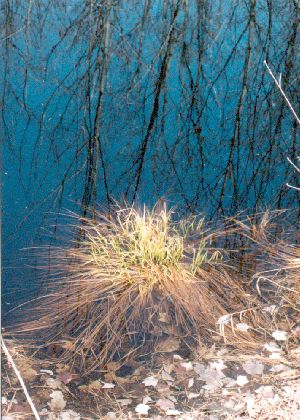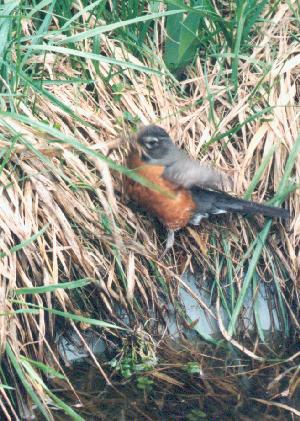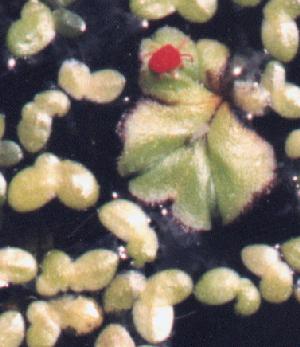Make a Pond for Wildlife
Ponds are places where cyanophytes still gleam with bubbles of pure oxygen, as they did two billion years ago. They are places where dragonflies still live as they did when they dominated the air 300 million years ago. Ponds are conservation in action.
Ponds are the whole world for many fascinating aquatic insects - whirligig beetles, backswimmers, water striders. They attract many of our favourite birds - swallows, flycatchers, wrens, ducks. But, they are a special boon to frogs. All Canadian frogs require clear water in which to breed - several require it year around.
Marshy ponds are the most valuable places of all to maintain biodiversity in most areas of Canada.
Location
It's best to protect existing ponds and marshes where wildlife already lives. In Southern Ontario, people have destroyed 80% of our wetlands, and more vanish every day through lack of protection. Next best is to restore wetlands where they once existed. But if neither of these is practical, or if you just love living surrounded by biodiversity as I do, build your own pond!
Depth
If the pond is deep enough that it doesn't freeze to the bottom during winter, it will support different species than if it is shallow. Fish, bullfrog, Green frog, leopard frog, and turtles require permanent water - a deep pond. All, however, eat small frogs and their tadpoles, so these prefer shallow water for breeding. Water lilies grow only where the roots do not freeze or dry out, but the water is shallow enough that new shoots can reach the surface in the spring on root-stored energy - a metre deep is best. Cattails and rushes require shallow but permanent water to fend off purple loosestrife.
Size
Toads, wood frogs and spring peepers will breed in as small a pond as a single square meter if there are aquatic plants established in it. Dragonflies breed in my backyard pond - it's only 2 m². You are unlikely to keep large frogs, however, with less than 5 m².
You will find among both bureaucrats and specialists a predisposition towards large size of things. For example, the Natural and Open Spaces Study of the City of Ottawa had on every page an evaluation bias for one large as opposed to many small natural areas. Almost all the conservation efforts of the federal government in this area have been poured into one huge site, the Mer Bleue, while several exceptional smaller federal lands, such as the Leitrim wetland, are being sold off to be destroyed. This is a serious error from the standpoint of biodiversity.
A natural ecological area needs to be of sufficient size to maintain itself in equilibrium - really tiny sizes are too vulnerable to accidents. However, sizes beyond that required for self-maintenance add very few extra species - except from the viewpoint of moose, the Mer Bleue is ten times the size it needs to be to maintain itself as a bog and support its diverse insect fauna. The resources expended on the Mer Bleue would far better protect biodiversity if they could be divided among ten different areas in the Ottawa region. So it is with ponds.
Ponds should be small enough that there can be one every kilometer. They can be deep or shallow, acid or alkaline, stagnant or flowing, sandy or clayey, surrounded by woods or grasslands.... If you value all living things, a small pond different from others around you is best, not joining in a single large project.
Liner
A deep pond of 10 m² or more in clay soil will probably not need a liner. If water already stands in the area for several months in the spring, perhaps all that is required is to deepen it. This is by far the most wildlife-friendly construction where it is possible. Small backyard ponds normally need to be lined to retain water over the summer. It is essential to not use swimming pool liners for this - they contain materials toxic to frogs and toads. Also, they are designed for the pH normally used in swimming pools, and break down very quickly otherwise. The plastics sold for building construction also break down rapidy in soil. The best liner is of the plastic designed for fish hatcheries. (In Ottawa Canada, Artistic Landscape Designs carries it.) Don't forget to provide a 'toad ramp', a gradually sloping edge where the 1 cm long toadlets can climb out.
Water Supply
Municipal water has to have pesticides added to kill bacteria that might otherwise kill us. Pure chlorine gases off fairly quickly, leaving chlorinated water in the sun for an afternoon is all that is required for it to be safe for wildlife. However many areas, including Ottawa-Carleton, use chloramines to sterilize water. They break down extremely slowly, and will kill most fish and amphibians at a tenth the concentration normally used in water supplies. If you live in such an area, you must obtain a neutralizing chemical from a tropical fish store and use it for any water you add to your pond. I run one of my house eave downspouts into a rain barrel, with a garden hose running from the barrel over to my pond. This method keeps pond things from being washed away during a cloudburst, but keeps the pond naturally full in all but the driest of summers here.
Habitat
Wildlife has to survive all year about your pond, not just the balmy summers. None but insect eggs can withstand freezing. Toads require loose soils (sandy is best) in which they can dig down below the frost line over winter. Most small frogs prefer leaf litter - a pile a meter deep will stay frost free in the middle in Ottawa. Only bullfrog, Green frog and leopard frog stay in water over the winter. Toads and small frogs spend most of their life out of water, eating insects and grubs that aren't poisoned by pesticides. Herbicides have relatively little effect on amphibians, but all insecticides, and most fungicides, are fatal even in tiny doses. However, don't give up just because an intolerant neighbour insists on poisoning his patch of the world. If you don't have sufficient safe habitat around your property, adopt a pond in an area that does. (Fortunately, urban residents of Ontario and Québec don't have to worry about this since provincial cosmetic pesticide bans were put in place.)
Stocking
A healthy pond has some earth on the bottom, and vegetation growing in it that emerges from the water, such as rushes or cattails. If your pond is in a healthy area, pond life will appear on its own, and it's much the best if it does. However, if there is no amphibian habitat within a kilometer, you will have to help them bridge the gap. After your pond has settled in for a season, listen for toads calling, then collect a few dozen eggs to stock your pond with. (Toad eggs are laid in single-strand strings, easy to recognize.) Two years later, they should return to your pond to breed and their calls will attract other wildlife that can survive in your area.
Legal
In Ontario, a natural accumulation of water (where water naturally occurs in any quantity, and no artificial retention such as a liner or dam is used) by default is free of legal impediments no matter what its size, depth or location. In most municipalities, any artificially-retained water deeper than 40 cm or so is considered a swimming pool, an 'attractive danger', and must be fenced. Your insurance company may require a policy endorsement for such a pond as well. However, municipal governments are empowered to make bylaws respecting the health and safety of their residents, and are thus permitted to enforce any restrictions they choose, even on 'natural' water bodies. Check with city (or township) hall before you build. Most municipal lawyers will try to discourage you, and a lot of junior bureaucrats as well. If you experience difficulty, talk to your councillor or mayor instead - they are the ones who will actually make the decision. Get a copy of The Federal Policy on Wetland Conservation from Environment Canada, Ottawa ON Canada K1A 0H3 to show what a fine upstanding Canadian you are, and The Urban Outback - Wetlands for Wildlife from the Metro Toronto Zoo, 361A Old Finch Ave., Scarborough ON Canada M1B 5K7, which was produced with provincial and federal support and has lots of real-life examples of small scale pond building.
Political Support
United Nations (Jakarta Indonesia November 1995): The biological diversity that
comprises variability of genes, species and ecosystems is the world's most valuable resource for the
sustainability and welfare of all humankind.
World Conservation Strategy: Wetlands, agricultural lands and forests are
humankind's key life support systems, and thus a vital element of national and global ecosystems
and economies.
Canada's Green Plan: Our personal health and the health of our environment
are bound tightly together. The Green Plan goal is to set aside as protected space 12% of the country.
Province of Ontario (Premier's Council January 1993): Healthy people thrive
in healthy environments. Objective 1: promote individual and community health and well-being by
protecting, preserving and restoring healthy ecosystems.
Regional Municipality of Ottawa-Carleton: The highest priority of the
community Visioning process is cleaning and protecting the environment.
City of Ottawa Natural & Open Spaces Study: citizens' top priority is to
preserve wetlands and natural forests in urban areas, as a quality of life issue.
Judicial Support

spring grass in a pond

A robin collecting nesting material at a pond edge. She will dip it in the water before
carrying it to weave into her nest.

A scarlet water mite, a millimeter long, browses on surface-floating liverwort and duckweed

A year in the life of a toad:
male calling,
pair mating,
eggs, newly hatched tadpoles,
older tadpole, toadlet ready to leave the pond,
ready to dig into sand for winter.